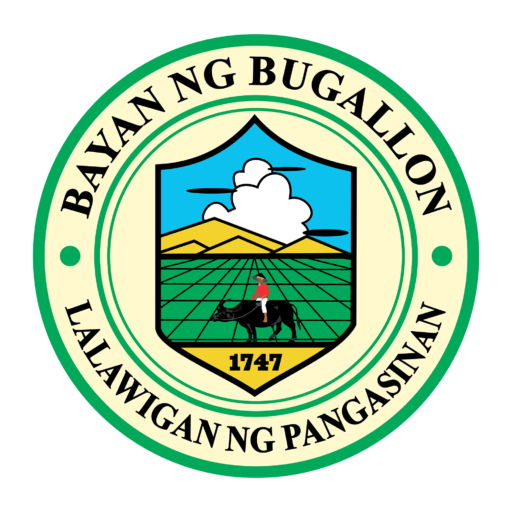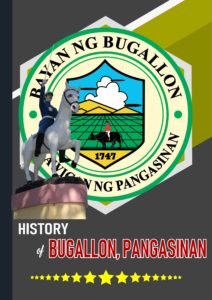HISTORY OF BUGALLON
The Municipality of Bugallon was formerly called “Salasa” which means a part of a wooden house where the floor is attached to. In the Spanish colonial era, the Spanish authorities established the town center in Poblacion (now Barangay Salasa). Because of flooding and erosion, the town center was later transferred to Barrio Anagao (became Barangay Poblacion but Our Lady of Lourdes Catholic Church, one of the oldest churches in the country, could not be transferred (every time someone attempts, he dies). A new Catholic church was created in the Poblacion, the Saint Andrew Catholic Church. This is the reason why Bugallon has two Catholic Churches. The town was named after the town’s hero Major Jose Torres Bugallon who fought together with Gen. Antonio Luna during the Philippine American War in 1899. February 5th, 1899, at the Battle of the La Loma, Bugallon faced Gen. Arthur Mac Arthur. Bugallon suffered a shot to the thigh during the battle. Later that day, in the arms of Antonio Luna, Bugallon died from excessive loss of blood.
In 1921, the town of Salasa was renamed to Bugallon.
The Municipality of Bugallon in the Province of Pangasinan is 202 kilometers North of Manila, 25 kilometers southeast of Dagupan City, 8 kilometers South of the capital town Lingayen and 40 kilometers South from one of the country’s tourist spots, the Hundred Island in Alaminos. It is bounded by Labrador on the West, San Carlos on the East, and Aguilar on the south.
Bugallon is a 2nd class municipality. The total area of our town is 189.64 sq.km (16,652 hectares). It is house of 13,832 (based on 2010 Census household) families, with an average of 5 members per family and a total population of 67,348 based on 2015 Census. The Municipality is politically and administratively divided into 24 barangays.
• Angarian
• Asinan
• Bañaga
• Bacabac
• Bolaoen
• Buenlag
• Cabayaoasan
• Cayanga
• Gueset
• Hacienda
• Laguit Centro
• Laguit Padilla
• Magtaking
• Pangascasan
• Pantal
• Poblacion
• Polong
• Portic
• Salasa
• Salomague Norte
• Salomague Sur
• Samat
• San Francisco
• Umanday
The Municipality is basically an agricultural municipality, our farmers produce rice, corn, cassava, sugar cane and vegetables. We have the famous Dumuloc Dam, located at Brgy. Cayanga that gives life to our rice fields. On top of our rice productions we also have fishfonds all of 237 hectares produce bangus and tilapia. To augment the meagre income of our marginalized farmers, the local government has program on municipal seed production and organic fertilizer. For technical assistance, the LGU provides various farmers class and rural improvement clubs (RICs) are organized. There are poultry contract growers, piggeries, sawali weaving in Magtaking Pantal,vinegar making made in nipa plants in brgy. Pantal and Brgy. Salasa, nipa shingles in Brgy. Salasa, Brgy. Bañaga and Brgy. Pantal. A fresh carabaos milk at Brgy. Umanday. We have our One Town One Product (OTOP) in our municipality which is the Duhat Wine located at Brgy. Laguit Padilla owned and managed by Laguit Padilla Multi-Purpose Cooperative, Inc. located at Barangay Laguit Padilla, Bugallon, Pangasinan.
The Municipality has two(2) Catholic churches, the Shrine of Our Lady of Lourdes in Barangay Salasa, believed by many to be miraculous and Saint Andrew Parish Church in Poblacion. We have 2 pilgrim sites in our town, Our Lady of Lourdes in Brgy. Salasa and Mt. Zion Pilgrim Mountain in Brgy. Laguit Padilla. There are 2 public cemeteries and 2 private cemetery Eternal Garden and Memorial Cemetery. There are two banks in our municipalty, the Rural Bank of Anda and GM Bank. Aside from our public market, we also have Slaughterhouse and Livestock Market. We have 2 Rural Health Units located at Poblacion and Brgy. Magtaking. We do have several privately owned medical and dental clinics, elementary schools in every barangays, 5 public high schools and 1 private high school. We also have 1 Municipal Library, 1 National Building for the national agencies concerned, Senior Citizen building for our elderly, Bureau of Fire Protection building and a newly-built Evacuation Center located at Municipal Grounds for the flooded barangays.
The Municipality has a water system provided by the Bugallon Water District (BUWAD) which caters to almost 70% of the total number of barangays. Central Pangasinan Electric Cooperative (CENPELCO) provided power supply for the entire municipality. Telephone line and internet connection is provided by the PLDT, Smart, Sun and Globe. We also have our Automated Teller Machine (ATM) beside our Municipal Hall. AMunicipal gym with sports facilities and a Gen. Jose Torres Park are in place for everyone to enjoy. We also have different tourist attractions for our tourist visitors.
Biography of Gen. Jose Torres Bugallon

Major Jose Torres Bugallon (b. August 28, 1873 – d. February 5, 1899) a revolutionary soldier, was officer in command of the Filipino army who fought the Spaniards in the Battle of La Loma in 1899. In 1896, he went to Toledo, Spain where he studied military organization and warfare. By December 10, 1898, after the Treaty of Paris, he worked as aide-de-camp of General Antonio Luna.
Jose’s father was from Baliwag, Bulacan and his mother was from a well-known Gonzalez family of Pangasinan. He was in the guardian of Rufino Villacruz who was a well-known schoolmaster of San Isidro, Nueva Ecija. In 1888, he studied at Colegio de San Juan de Letran where he took up his secondary course, with excellent grades. He entered the Seminary of San Carlos but his real passion was to become a soldier, he took up a military entrance exam. After passing the validation, he was granted to study at the Military Academy of Toledo, Spain, 1892, where he studied for three years and concentrated in the study of military organization and warfare
Upon his return, he was appointed second lieutenant by the Spanish army and served under the 70th Infantry regiment. After the batlle of Talisay, Batangas, May 30, 1897, he was promoted to captain and was awarded the highest medal of San Fernando. He was also awarded with Cross of Maria Cristina and the Red Cross for Military Honor (Cruz Roja Del Merito Militar). After the Treaty of Paris, he obtained clearance papers. When the Americans came to the Philippines on February 1899, he joined the the rebels. Gen. Antonio Luna needed instructors for his officers in the European art of warfare at Malolos,Bulacan. He was the aide-de-camp and the recruiter of the Spanish war veteran. His knowledge was very instrumental in the reorganization and dicipline of the Filipino soldiers at that time.
On February 5, 1899, he was in La Loma defending the fronline. The Americans under Gen. Douglas MacArthur were attacking their defences at that time. They were outflanked, thus exposing Bugallon to the advanced firepower of the enemies, he was hit by a bullet in the thighs. Col. Queri told Gen. Luna Bugallon was wounded, The general ordered: ” Bugallon wounded. Order forward. He must be saved at all cost. Bugallon is worth 500 Filipino soldiers . he is one of my hopes for future victory.” After which, the general found him along side of the road. All that he could utter was “My….. don’t expose yourself so much. Don’t advance any further.” He was withdrawn by Commander Hernando and Gen. Luna himself, he was taken to Kalookan medical station where he was given first aid by Dr. Jose Luna and Santiago Barcelona. Later was rushed by train to Malolos, Bulacan for hospitalization, somewhere after Lolomboy and nearing Bocaue, Bulacan, Bugallon asked “Have the reinforcement arrived?”, But he was too weak to keep up and he was bleeding, he died in the greast of Gen. Antonio Luna.
Bugallon was promoted to Lieutenant Colonel after his display of gallantry in battle and heroism. The former town of Salasa in Pangasinan was renamed Bugallon in honor of Jose Torres Bugallon. This was law sponsored by Congressman Mauro Navarro of Pangasinan in 1921 to perpetute Bugallon’s gallantry. His remains lie in Sampalok Church in Manila.
BIOGRAPHY OF ST. ANDREW
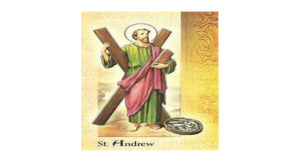
Saint Andrew was the first disciple of Jesus. He was the younger brother of Saint Peter and was born in Bethsalda on the Sea of Galilee. The brothers were fishermen by trade. Jesus called them to be his disciples by saying that he would make them “fishers of men”.
The Gospel of John teaches us much about St. Andrew who was originally a disciple of St. John the Baptist. When John pointed to Jesus and said, “Behold the Lamb of God!”. Andrew understood that Jesus was greater and immediately left John to follow Jesus. He visited in Jesus’ home and later brought Simon Peter, who Jesus also called to be an apostle.
It is believed that Saint Andrew and Saint Peter continued their trade as fishermen until Christ called them to a closer relationship, and they left all things to follow Jesus.
After Christ’s crucifixion and resurrection, St. Andrew the Apostle preached the gospel in Asia Minor and in Scythia as far as Kiev. Not much is mentioned in the Book of Acts regarding the life of Saint Andrew.
Saint Andrew was martyred by crucifixion of Patras in Achaea in Greece. Because St. Andrew deemed himself unworthy to be crucified on the same type of cross on which Christ has been crucified, he asked to be tied to a Crux decussate or an X shaped cross. The Apostle Andrew did not die right away but instead he was left to suffer for two days while he continued to preach the gospel of Jesus Christ until he finally died.
Although little is mentioned in the Book of Acts regarding the life of St. Andrew, much can be learned through St. Andrew’s life. He and St. Peter gave up their lifelong careers and lifestyles, leaving everything behind, to follow Jesus. Their underlying faith in a difficult world is an inspiration to all Christians.
His relics consist of a small finer, the top of his cranium and pieces of the cross. These are kept in a shrine at the Church of St. Andrew in Patras.
Saint Andrew is the Patron Saint of Scotland, Russia and Greece. Scots celebrate Saint Andrew’s Day around the world on the 30th of November. The flag of Scotland is the Cross of St. Andrew.
HISTORY OF ST. ANDREW CATHOLIC CHURCH
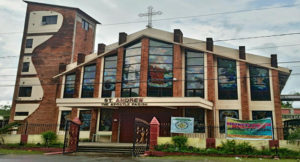
The earliest inhabitants of Bugallon were groups of people from Lingayen, Binmaley and San Carlos, who, sometime before 1720, migrated to a fertile virgin land named “Salasa”. When this incipient community grew into a town proper, having its own barrios including Anagao. Two hundred years later, through a Provincial Board Resolution on 1916, Anagao became the town proper and Salasa became its principal barangay. This was due to the inevitable danger posed by the erosion of the Agno River during the big flood in 1914. On February 27, 1924, through Philippine legislature, the town subsequently got its present name “Bugallon” in honor of one of General Antonio Luna’s gallant officers and native of this place – General Jose Torres Bugallon, who valiantly fought the invading Americans in the battle of La Loma where he was consequently killed on February 1899.
The Spanish Dominican Friars, who formed the founding families into a visita of the Parish of Lingayen, found them to be industrious and practical agriculturist but unable to to live harmoniously among themselves. The animosity diminished, however, and along the way, Salasa became an independent parish under the patronage of Saint Andrew the Apostle. It was in the year 1747 when a Dominican Friar named Fr. Francisco Barozo, OP, built the church in Salasa. Thanks to the pastoral care of those missionaries who, unfortunately, were forced to leave the place in 1898 because of the Philippine Revolution.
Their departure created vacuum for three decades. Quarrels resurfaced, the new Aglipayan sect was gaining adherents, and the American Protestants were about to step in.
Then on September 17, 1930, (Feast of the Stigmata of St. Francis of Assisi), a group of Franciscan Capuchin Friars, fresh from Spain, came to the rescue through the invitation of Bishop Cesar Maria Guerrero, D.D., the first Bishop of Pangasinan, who was himself a Franciscan Tertiary.
They took over the Parishes of Salasa and Bugallon, with Our Lady of Lourdes and Saint Andrew, the Apostle as the patron saints respectively.
After thirty one years of zealously caring the pastoral and spiritual needs of the people of Bugallon, the Capuchin Friars left the place. Due to the growing number of the diocesan clergy, the parish was turned over to the Diocese of Lingayen on May 1961. However, on November 22, 1991, the Saint Andrew Parish of Bugallon was again entrusted by Bishop Jesus A. Cabrera, D.D. to the care of the Capuchins with Fr. Jesus Chua Mendoza, OFM Cap as the Parish Priest, Fr. Wilson B. Ramirez as Co-Pastor. Then after some months, Fr. Francisco Almario, OFM Cap took over the place of Fr. Wilson B. Ramirez. After the demise of Fr. Jesus Chua Mendoza, Fr. Armando A. Baraan, OFM Cap became the Parish Priest with Fr. Wilson B. Ramirez as Co-Pastor. With the new appointment of Fr. Armando A. Baraan, Fr. Wilson B. Ramirez became the Parish Priest with Fr. Serving Bustamante, OFM Cap as Co-Pastor and Bro. Nanding Landingin, OFM Cap as Co-Worker.
The Parish is back under the care of the Diocese of Alaminos upon the arrival of Bishop Mario M. Peralta, D.D. on May 2, 2006. Bishop Mario M. Peralta stayed in the parish during his term as Co-Adjutor Bishop of the Diocese of Alaminos together with Fr. Dominador Mendoza, Jr. who was appointed as Co-Pastor on July 2006. From June 2011 to June 2012, Rev. Fr. Jonas Centeno became the Pastor of the Parish. On June 2012, Rev. Fr. Benigno Q. Vinluan was assigned as the Parish Priest until July 2016. Presently, the parish is being cared pastorally by Rev. Fr. Eduardo E. Inacay as the Parish Priest and Rev. Fr. Julius Joseph B. Lucero as the Parochial Vicar.
The Saint Andrew Catholic School which is adjacent to the parish is being administered by Sr. Mary Eileen Grace S. Suacillo, SPC, as the Directress.
OUR LADY OF LOURDES PARISH CHURCH
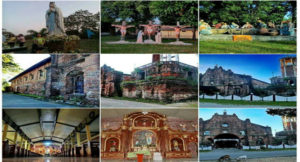
The original Our Lady of Lourdes Parish Church, also known as the Salasa Parish Church (or simply Salasa Church), is a Spanish colonial church located in the municipality of Bugallon in Pangasinan, Philippines. The church is under the jurisdiction of the Roman Catholic Diocese of Alaminos.[1] Its feast day is celebrated every February 11.
church of old town Salasa. In the early part of the 20th century, flooding and erosion threatened the entire town of Salasa. Plans for this church were to be moved to the town of Anagao, but lifting machines and personnel could not move or lift the artifacts inside the church. Considered to be divine intervention the church and artifacts stayed. It is rumored the builders who tried to dismantle the church died one after the other. Another attempt was made to move the church to the new town of Bugallon but was met with the same results; Bugallon later established their own church. The impressive huge structure of the original bell tower was knocked down and destroyed during one of the strongest typhoons to hit Pangasinan.
History
Father Antonio Perez founded the Salasa Parish in 1714 and built a church from 1720 up to 1733. With his efforts, the church was accepted as a Dominican Order vicariate. Father Francisco Barroso began the construction of the church in 1747 and finished the work in 1748. Fr. Juan Terres made repairs and renovations on the church from 1874 to 1885. [2] In 1937, the church was opened under the Capuchin monks with Our Lady of Lourdes as their Patron. However, due to the Great Flood of 1953 caused by the overflowing of Agno River, the church suffered massive damages. Its roof, images, benches, liturgical objects were transferred to its present site in the barangay of Salasa except the two side altars and the Saint Andrew the Apostle statue at the façade, which remained at its location in the poblacion.
Architectural features
The church reflects the Spanish Colonial Revival architectural style and measures 81 meters (266 ft.) by 21.3 metres (70 ft).Its plastered brick facade was inspired by the Mexican style. The pediment is flat-topped and decorated with massive pinnacles. The octagonal window, together with the semicircular door and windows, accentuates the plastered finish wall. Its square pilasters, reaching up to the roof, are also decorated with pinnacles.
Nearby cities: San Carlos City, Alaminos City, Tarlac City
Coordinates: 15°58’45″N 120°13’9″E

